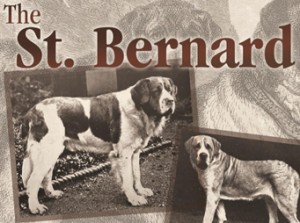The St. Bernard – A Storied History
274 – February 2017
BY LEE CONNOR
 Isn’t it incredible that despite the plethora of channels on TV we are often at a loss when looking for something to enter- tain us, and I’m certainly finding that when I do finally settle on something it is invariably a show from the past.
Isn’t it incredible that despite the plethora of channels on TV we are often at a loss when looking for something to enter- tain us, and I’m certainly finding that when I do finally settle on something it is invariably a show from the past.
I noticed this during the recent holidays; the weather outside was foul and it was that interminable stretch of days between Christmas and New Year that had me reaching for the remote control and searching for something to watch. I found myself settling on an episode of Columbo, the unassuming, dishevelled police detective from the LAPD – you remember him – the de- tective with the formidable eye for detail, who, despite his bum- bling apparent absentmindedness, always managed to shrewdly solve and secure the necessary evidence to solve his cases. One talent that Columbo had, that is also a very useful one for the budding canine historian, is to take a particular story and work back to the source – the inverted detective.
So often in our world of pedigree dogs one finds a story pre- sented by one authority, that is then repeated and embellished over the future decades by other experts and authors until the nugget of truth is almost completely lost. However by stripping back the tale and getting as close to the original source as possible we can sometimes recover something of the truth.
This is certainly the case with the St. Bernard – a magnificent breed that has legend and mythology swirling all around it. It seems that a popular breed needs a certain mythology about it. Our Victorian forefathers knew the importance of a good story when it came to promoting a new breed and surely no breed has appealed more to the kindly instincts of humanity than the St. Bernard. He earned his laurels and his popularity on the treach- erous mountain slopes of Switzerland. For years stories were told of this breed’s intelligence, tales were told of the St. Bernard as a hero and how he saved the lives of travellers overcome by sudden snowstorms.
We often hear the romantic tale of the Hospice of St. Bernard high in the Alps, where the monks had bred and reared an ex- traordinarily intelligent breed of dog and had trained him to go out in the fierce snowstorms and seek out any poor traveler who had lost his way and ‘who might lie beneath a snow wreath mid- way between life and death.’
Victorian children were taught about the selflessness of these incredible dogs from the hospice, usually depicted by painters of the time, on a snowy precipice with a small barrel of warming and invigorating brandy (sadly yet another myth that grew up around the fabulous portrait by Edwin Landseer ‘Alpine Mastiffs re-animating a traveller, 1831’ ) around their necks. Very few Victorian/Edwardian school children wouldn’t have heard of the lifesaving exploits of Barry, the most famous and bravest of the St. Bernard Hospice dogs, who in his lifetime was accredited with saving fifteen lives (although over the years this number has crept up to between forty and seventy-five with the retelling of the story!). Renowned canine writers Idstone and Stonehenge give the figure of forty-two but ‘father of the St. Bernard’ (and clever propagandist!) the Rev. J.C. Mac- dona enthusiastically lifted that number to seventy-five! J.C. Macdona sounded like a fascinating character. He even left the Church to devote his whole time to advertising and promoting his precious breed and by pushing the fame of ‘Barry’ at every possible opportunity, it was said that he almost convinced the British populace that the Hospice was named after the dogs rather than the other way round!
Click here to read the complete article274 – February 2017
Short URL: http://caninechronicle.com/?p=119802
Comments are closed











